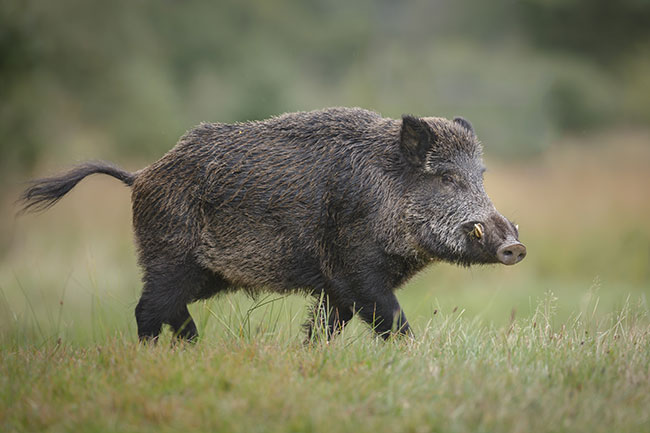
Features
Pests
Silencing the sounder
Saskatchewan producers are eligible for up to 100 per cent coverage for damages caused by wildlife.
April 26, 2023 By Julienne Isaacs
 Wild boar sounder: feral wild boars are typically darker in colouring and thinner than most of their domesticated cousins, and are sometimes tusked.
Photo courtesy of Natureimmortal /ADOBE STOCK.
Wild boar sounder: feral wild boars are typically darker in colouring and thinner than most of their domesticated cousins, and are sometimes tusked.
Photo courtesy of Natureimmortal /ADOBE STOCK. It’s difficult to estimate the number of feral wild boar in Saskatchewan, says Dale Knouse, manager of strategic operations for Saskatchewan Crop Insurance Corporation (SCIC).
That’s because the estimated population is based on damage reports and sightings, and groups of wild boar – “sounders” – are mostly active at night.
Eurasian pigs were introduced to the province in the 1970s as part of efforts to diversify agriculture. But, escapees have rapidly increased the population of feral boar – technically any pig “outside the fence” for which ownership can’t be established, according to Sask Pork’s website, and the animals are considered an invasive pest.
Wild boar can damage cropland via rooting, nesting and trampling. The pigs can also harass livestock and are potential vectors for diseases, including African swine flu, says Knouse.
SCIC’s Feral Wild Boar Control Program, a collaborative effort with the Saskatchewan Ministry of Agriculture, the Saskatchewan Ministry of Environment and other provincial stakeholders, has been running since 2017. The program, which manages the control of wild boar and coordinates public sightings, started on a small scale, says Knouse, “but over time we identified best practices and built the team up to where we are today.”
Conventional wisdom typically holds that animal pests can be controlled at least in part through the use of hunting bounties. But, the practice isn’t recommended, says Knouse. “If people try to hunt them with a rifle and try to chase them, you scatter them,” he says. “That [could] split up a sounder into two or three groups, and that causes the problem to spread. We want people to tell us where they are but leave them alone.”
SCIC manages a group of hunters and trackers who have experience with wild boar and understand the challenges of controlling the animals, he says. “They are the ones who respond using specific protocols to determine the next actions.”
One of the techniques deployed by these groups is the use of baited corrals with remote triggers. This option increases the odds that an entire sounder can be captured, says Knouse.
Over the past two years, the program has been quite successful, and Knouse says the province has a “decent handle” on the population.
But, the pest has spread across Western Canada, and is by no means contained across these jurisdictions. SCIC works with other monitoring groups, including the Canadian Invasive Wild Pig Operational Working Group and other provincial working groups. It also worked with the Feral Swine Transboundary Work Group, a U.S.-Canada working group that comprises the four western Canadian provinces, the four western Canadian territories and western U.S. states that recognize a threat from feral wild pigs, and published a report in 2020.
Although the report referenced a total North American population of over six million, so far, feral wild boar are not known to have spread from Western Canada to Washington or Montana.
“Ours is probably the most mature program – we’re called on quite a bit by other jurisdictions for best practices and ideas,” says Knouse.
Reporting and claims
The program’s success rests on reports of wild boar sightings. SCIC tries to make reporting as easy as possible – the public can report by calling a toll-free number, sending an email or using a reportage tool on the Feral Wild Boar Control Program webpage.
There is variation in colour due to cross-breeding with domestic species, but feral wild boar are typically darker in colouring and thinner than most of their domesticated cousins, and are sometimes tusked.
The Invasive Species Council of British Columbia notes that males typically weigh 60 to 200 kg, while females weigh 35 to 150 kg.
“If people are able to take photos or videos of wild boar, that helps us identify it. At times there are pig sightings that are not wild boar,” says Knouse. “There are domestic escapes, or some farms may have a dark-coloured European species and they’re kept in a corral. [In that case], we work with the municipality to identify and contain the animals.”
Domestic escapes are much easier to catch.
If possible, says SCIC, try to identify the date, time and GPS coordinates or nearby landmarks of the sighting, count the number of animals in the sounder and note whether there are piglets present.
In Saskatchewan, producers are eligible for up to 100 per cent coverage for crop damages caused by wildlife, even when losses aren’t significant (Knouse says most damage is caused by elk and deer, as well as bears, migratory waterfowl and wild boar).
If producers suspect that damage to crops was caused by wild animals even if none are sighted, they should photo-document the damage and call SCIC to make a claim, after which, SCIC will send an adjuster out to the field.
If landowners or producers spot wild boar in their fields, it’s critical they don’t resort to taking matters into their own hands.
“This is a group effort, and the public is involved in that group,” says Knouse. “Their reporting of these sightings is a big part of this. We can’t stress enough that if you have an opportunity to report, please do so.”
Producers can call or text the Saskatchewan Pork Development Board (SaskPork) reporting line at 1-833-PIG-SPOT.